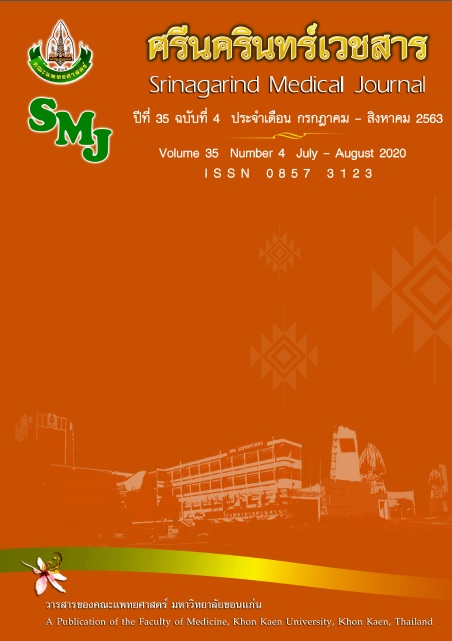Triggers and Risks Factor for Admission in Patients with Asthma Exacerbation: A Study from an Emergency Room Registration Database in a Tertiary Hospital in Northeastern Thailand
Abstract
ปัจจัยกระตุ้น และปัจจัยเสี่ยงต่อการนอนโรงพยาบาลของผู้ป่วยโรคหืดกำเริบเฉียบพลัน: การศึกษาจากฐานข้อมูลการลงทะเบียนในโรงพยาบาลระดับตติยภูมิในภาคตะวันออกเฉียงเหนือของประเทศไทย
ดารา ไม้เรียง1, แพรว โคตรรุฉิน2, กมลชนก ภูโอบ2,
1ภาควิชากุมารเวชศาสตร์ คณะแพทยศาสตร์ มหาวิทยาลัยขอนแก่น จ.ขอนแก่น
2โครงการจัดตั้งภาควิชาเวชศาสตร์ฉุกเฉิน คณะแพทยศาสตร์ มหาวิทยาลัยขอนแก่น จ.ขอนแก่น
หลักการและวัตถุประสงค์: โรคหืดกำเริบเฉียบพลันเป็นหนึ่งในสาเหตุสำคัญของการมาตรวจรักษาที่ห้องฉุกเฉิน หากทราบปัจจัยเสี่ยงต่อการนอนโรงพยาบาลของผู้ป่วย จะทำให้รักษาผู้ป่วยได้อย่างทันท่วงที และช่วยในการตัดสินใจรับรักษาเป็นผู้ป่วยในได้เร็วขึ้น นอกจากนี้หากทราบปัจจัยกระตุ้นของโรคหืดกำเริบเฉียบพลันก็จะทำให้ป้องกันการหืดกำเริบได้ดีขึ้น การศึกษานี้จึงมีวัตถุประสงค์ค้นหาปัจจัยเสี่ยงต่อการนอนโรงพยาบาล และปัจจัยกระตุ้นของการเกิดโรคหืดกำเริบเฉียบพลัน
วิธีการศึกษา: การศึกษานี้เป็นการศึกษาย้อนหลังเชิงพรรณนาจากฐานข้อมูลการลงทะเบียนผู้ป่วยโรคหืดกำเริบเฉียบพลันที่มารับการรักษาที่แผนกฉุกเฉิน โรงพยาบาลศรีนครินทร์ มหาวิทยาลัยขอนแก่น จังหวัดขอนแก่น โดยศึกษาในผู้ป่วยที่มีอายุตั้งแต่ 12 ปีขึ้นในช่วงเดือนพฤศจิกายน 2559 -ธันวาคม 2560 ข้อมูลที่ศึกษาประกอบด้วยข้อมูลทางประชากร ปัจจัยกระตุ้น ประวัติโรคหืด ลักษณะทางคลินิกแรกรับ และการรักษาที่แผนกฉุกเฉิน โดยเปรียบเทียบความแตกต่างของผู้ป่วยที่ต้องนอนโรงพยาบาลกับผู้ป่วยที่ไม่ต้องนอนโรงพยาบาลเพื่อหาปัจจัยเสี่ยงต่อการนอนโรงพยาบาลของผู้ป่วยโรคหืดกำเริบเฉียบพลัน
ผลการศึกษา: ผู้ป่วย 73 ราย ได้รับเข้าในการศึกษา ผู้ป่วยหกราย (ร้อยละ 8.21) ต้องได้รับการรักษาเป็นผู้ป่วยใน โดยปัจจัยเสี่ยงของการนอนในโรงพยาบาล ได้แก่ มีโรคประจำตัวเกี่ยวกับหัวใจและหลอดเลือด หรือทางเดินหายใจ (OR 6.38, 95%CI 1.07-38.1, p = 0.044) ต้องใช้ออกซิเจนในการรักษา (OR 1.2,95%CI 1.04-1.34, p = 0.01) และอัตราการหายใจแรกรับมากกว่าหรือเท่ากับ 28 ครั้งต่อนาที (OR 2.44, 95%CI 1.94- 3.6, p =0.005) ปัจจัยกระตุ้นโรคหืดกำเริบเฉียบพลันที่พบบ่อยที่สุด คือ การติดเชื้อทางเดินหายใจส่วนต้น (ร้อยละ 38.81%) และการใช้ยาไม่สม่ำเสมอ (ร้อยละ 16.42%) ตามลำดับ
สรุป: ปัจจัยเสี่ยงต่อการนอนโรงพยาบาลของผู้ป่วยโรคหืดกำเริบเฉียบพลัน ได้แก่ มีโรคประจำตัวเกี่ยวกับหัวใจและหลอดเลือด หรือทางเดินหายใจ ต้องใช้ออกซิเจนในการรักษา และอัตราการหายใจแรกรับมากกว่าหรือเท่ากับ 28 ครั้งต่อนาที ปัจจัยกระตุ้นโรคหืดกำเริบเฉียบพลันที่พบบ่อยที่สุด คือ การติดเชื้อทางเดินหายใจส่วนต้น และใช้ยาไม่สม่ำเสมอ
คำสำคัญ: โรคหืดกำเริบเฉียบพลัน; ปัจจัยเสี่ยงต่อการนอนโรงพยาบาล; ปัจจัยกระตุ้นโรคหืดกำเริบเฉียบพลัน
Background and objective: Asthma exacerbation is one of the common causes of emergency room visits. Recognizing risk factors for admission could lead to early management and a rapid decision for admission. Identifying the triggers of asthma exacerbation could help to establish effective preventive strategies. This study aimed to identify risk factors for hospital admission and triggers of asthma exacerbation.
Methods: A descriptive, retrospective study was conducted using data from the asthma exacerbation registration database of Emergency department, Srinagarind hospital, Khon Kaen university, Thailand. Children and adults aged > 12 years with asthma exacerbation, who visited our emergency room from November 2016- December 2017, were registered in the database.
The registration data consisted of demographic data, triggers of asthma exacerbation, asthma history, clinical presentation at initial assessment, and management at an emergency room. The data of admitted and non-admitted patients were compared and analyzed to identify risk factors for admission.
Results: Seventy-three patients were included. Six patients (8.21%) were admitted. Risks for admission were presence of underlying cardiovascular or respiratory diseases (OR 6.38, 95%CI 1.07-38.1, p = 0.044), requiring oxygen therapy (OR 1.2,95%CI 1.04-1.34, p = 0.01), and initial respiratory rate > 28 breaths/minute (OR 2.44, 95%CI 1.94- 3.6, p =0.005). The most common and the second most common triggers of asthma exacerbation were upper respiratory tract infection (38.81%) and poor adherence (16.42%), respectively
Conclusion: Risk factors for admission in patients with asthma exacerbation were presence of underlying cardiovascular or respiratory diseases, requiring oxygen therapy and initial respiratory rate > 28 breaths/minute. Upper respiratory tract infection and poor adherence were the two most common triggers of asthma exacerbation.
Keyword: asthma exacerbation; risk factors for admission; triggersofosthma exacerbation
Introduction
Asthma exacerbation is one of the common causes of emergency room visits 1,2. A significant number of asthmatic patients needs hospital admission 3,4, causing personal and public health burdens5. Hospitalization also increases risk of fatal and near-fatal asthma and is a risk factor for fixed airflow limitation6.
Several clinical scoring systems with varied validity have been developed for assessing the severity of asthma exacerbation 7,8. However, there is no consensus on which scoring system should be used. Furthermore, in an emergency situation and overcrowded emergency room setting, it is difficult for physicians to memorize and calculate severity scores, let alone remember the cut-off points. In addition, identifying the triggers of asthma exacerbation could help to establish effective preventive strategies. Therefore, we conducted a study to identify specific and feasible clinical markers, and risk factors for hospital admission, for routine use in a real-life emergency setting, assisting physicians to make rapid decisions when admission may be needed. Triggers of asthma exacerbation were also assessed.


